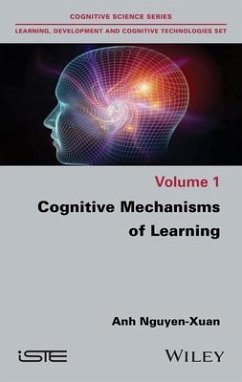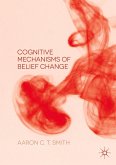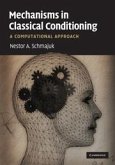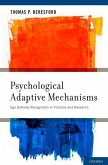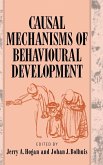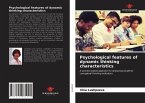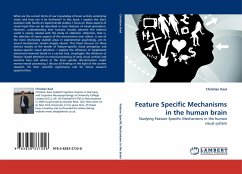Anh Nguyen-Xuan
Cognitive Mechanisms of Learning
Anh Nguyen-Xuan
Cognitive Mechanisms of Learning
- Gebundenes Buch
- Merkliste
- Auf die Merkliste
- Bewerten Bewerten
- Teilen
- Produkt teilen
- Produkterinnerung
- Produkterinnerung
Cognitive Mechanisms of Learning presents experimental research works on the issue of knowledge acquisition in Cognitive Psychology. These research works - initiated by groups of researchers with academic backgrounds in Philosophy, Psychology, Linguistics and Artificial Intelligence - explore learning mechanisms by viewing humans as information processing systems. Although the book is centered on research studies conducted in a laboratory, one chapter is dedicated to applied research studies, derived directly from the fundamental research works. Computer modeling of learning mechanisms is…mehr
Andere Kunden interessierten sich auch für
![Cognitive Mechanisms of Belief Change Cognitive Mechanisms of Belief Change]() Aaron C. T. SmithCognitive Mechanisms of Belief Change49,99 €
Aaron C. T. SmithCognitive Mechanisms of Belief Change49,99 €![Mechanisms in Classical Conditioning Mechanisms in Classical Conditioning]() Nestor SchmajukMechanisms in Classical Conditioning133,99 €
Nestor SchmajukMechanisms in Classical Conditioning133,99 €![Mechanisms of Social Connection: From Brain to Group Mechanisms of Social Connection: From Brain to Group]() Mechanisms of Social Connection: From Brain to Group110,99 €
Mechanisms of Social Connection: From Brain to Group110,99 €![Psychological Adaptive Mechanisms Psychological Adaptive Mechanisms]() Thomas P Beresford MDPsychological Adaptive Mechanisms126,99 €
Thomas P Beresford MDPsychological Adaptive Mechanisms126,99 €![Causal Mechanisms of Behavioural Development Causal Mechanisms of Behavioural Development]() Jerry A Hogan / Johan Bolhuis (eds.)Causal Mechanisms of Behavioural Development160,99 €
Jerry A Hogan / Johan Bolhuis (eds.)Causal Mechanisms of Behavioural Development160,99 €![Psychological features of dynamic thinking characteristics Psychological features of dynamic thinking characteristics]() Irina LushpaevaPsychological features of dynamic thinking characteristics32,99 €
Irina LushpaevaPsychological features of dynamic thinking characteristics32,99 €![Feature Specific Mechanisms in the human brain Feature Specific Mechanisms in the human brain]() Christian KaulFeature Specific Mechanisms in the human brain38,99 €
Christian KaulFeature Specific Mechanisms in the human brain38,99 €-
-
-
Cognitive Mechanisms of Learning presents experimental research works on the issue of knowledge acquisition in Cognitive Psychology. These research works - initiated by groups of researchers with academic backgrounds in Philosophy, Psychology, Linguistics and Artificial Intelligence - explore learning mechanisms by viewing humans as information processing systems. Although the book is centered on research studies conducted in a laboratory, one chapter is dedicated to applied research studies, derived directly from the fundamental research works. Computer modeling of learning mechanisms is presented, based on the concept of �cognitive architecture�. Three important issues - �the methodology�, �the achievements� and �the evolution� - in the field of learning research are also examined.
Hinweis: Dieser Artikel kann nur an eine deutsche Lieferadresse ausgeliefert werden.
Hinweis: Dieser Artikel kann nur an eine deutsche Lieferadresse ausgeliefert werden.
Produktdetails
- Produktdetails
- Verlag: Wiley
- Seitenzahl: 320
- Erscheinungstermin: 13. Oktober 2020
- Englisch
- Abmessung: 236mm x 155mm x 23mm
- Gewicht: 794g
- ISBN-13: 9781786305770
- ISBN-10: 1786305771
- Artikelnr.: 59942628
- Herstellerkennzeichnung
- Libri GmbH
- Europaallee 1
- 36244 Bad Hersfeld
- gpsr@libri.de
- Verlag: Wiley
- Seitenzahl: 320
- Erscheinungstermin: 13. Oktober 2020
- Englisch
- Abmessung: 236mm x 155mm x 23mm
- Gewicht: 794g
- ISBN-13: 9781786305770
- ISBN-10: 1786305771
- Artikelnr.: 59942628
- Herstellerkennzeichnung
- Libri GmbH
- Europaallee 1
- 36244 Bad Hersfeld
- gpsr@libri.de
Anh Nguyen-Xuan is a retired director of research at the French National Center for Scientific Research (CNRS). Her research works are mainly interdisciplinary (Cognitive Psychology, Artificial Intelligence, Didactics of Physics, Didactics of Mathematics) and focused on learning and cognitive development.
Foreword ix
Acknowledgments xiii
Introduction xv
Chapter 1. Useful Concepts and Representation Formalisms 1
1.1. Useful concepts 1
1.1.1. Information 1
1.1.2. Information processing 2
1.1.3. Problem 2
1.1.4. Comprehension 4
1.1.5. Memory 6
1.2. Some formalisms used in cognitive psychology to represent knowledge
stored in the LTM 10
1.2.1. Semantic networks: a representation formalism for declarative
knowledge 11
1.2.2. A representation formalism for procedural knowledge 13
1.2.3. A representation formalism for the comprehension process 16
Chapter 2. Definition and Historical Overview 23
2.1. Definition 23
2.2. Conceptual frameworks 26
2.3. Principal concepts of problem-solving 28
2.3.1. The "problem space" and "path" concepts 29
2.3.2. The "heuristic" and "search tree" concepts 32
2.4. Formal models 35
2.4.1. Models based on rules of production 36
Chapter 3. Learning to Solve a Problem 43
3.1. Breaking down a complex problem into sub-problems 44
3.1.1. Lee, J. and Anderson, J.R. (2001) 44
3.2. The four stages of problem-solving 52
3.2.1. Anderson, Pyke and Fincham (2016) 52
3.3. The three stages of learning by problem-solving 56
3.3.1. Tenison, Fincham and Anderson (2016) 56
Chapter 4. Learning a Concept from Examples of Concepts: Induction 63
4.1. Rule-based category learning 67
4.2. The question of "confirmation bias" 72
4.3. The duality between rule-based concept identification and
similarity-based concept identification 75
4.4. Concluding remarks 85
Chapter 5. Implicit Learning 89
5.1. Presentation 89
5.2. What have learners learned, and are they aware of the knowledge which
they acquire? 92
5.2.1. The princeps research work 92
5.2.2. What knowledge does the subject need to acquire? 99
5.3. Fragment status and the question of "abstract" or "concrete" acquired
knowledge 102
5.3.1. The status of fragments in artificial grammar learning experiments
102
5.3.2. The nature of acquired knowledge: abstract or concrete? 104
5.4. Conclusion on implicit learning 107
5.4.1. Implicit learning and statistical learning 107
5.4.2. Individual differences 109
5.4.3. Statistical learning mechanisms 110
5.4.4. Applications of statistical learning 111
Chapter 6. The Role of Prior Knowledge in Constructing a Representation of
a Problem 113
6.1. Experimental method based on comparing group results 114
6.2. Experimental method based on multiple trials of the same problem with
vocal description of actions by the subject: individual protocol and
modeling 123
6.3. Experimental method using learning transfer to study the effect of
problem presentation in the choice of prior knowledge 126
6.3.1. General hypotheses 127
6.3.2. Material used 128
6.3.3. Experimental hypotheses 131
6.3.4. The experiments 132
6.3.5. Conclusion 139
6.4. Conclusion: the role of prior knowledge in the construction of problem
representations 139
Chapter 7. Acquiring Knowledge in a Specific Domain 143
7.1. Learning through (self-)explanation 143
7.1.1. Learning to solve problems by studying examples of solutions 144
7.1.2. Acquisition of declarative knowledge concerning the human
circulatory system 147
7.1.3. Knowledge acquisition in physics 154
7.1.4. Brief conclusion 160
7.2. Problem-based learning 161
7.2.1. Results 164
7.3. Appendix: some notes on cognitive load theory 165
Chapter 8. Causal Learning 169
8.1. Historical overview 170
8.2. Conceptual framework 172
8.2.1. Temporal and spatial contiguity 172
8.2.2. Temporal priority: cause before effect 173
8.2.3. Contingency 174
8.2.4. Prior experience 175
8.3. Formalization and experimental research on adults 176
8.3.1. Probabilistic models of causal learning 177
8.3.2. Two examples of research on adults 180
8.3.3. Causal learning in adults: conclusion 193
8.4. Experimental research on children 194
8.4.1. The above/below relation 196
8.4.2. The "same/different" relation 198
8.4.3. Knowledge of the domain in which a problem situation is represented
200
8.4.4. Self-directed learning in children 203
8.4.5. Conclusion: causal learning in children 204
Chapter 9. Symbolic Processing System Models in Cognitive Psychology 213
9.1. Why formalize? 213
9.2. Modeling complex skill acquisition using ACT-R 214
9.3. Modeling a two-player game 219
9.4. A model of learning through multiple analogies 229
9.4.1. Knowledge acquisition: first type 230
9.4.2. Knowledge acquisition: second type 232
9.5. Robert Siegler's two models for learning arithmetic calculation 239
9.6. Links between SPS models in cognitive psychology and learning models
in AI 247
Conclusion 251
References 261
Index 285
Acknowledgments xiii
Introduction xv
Chapter 1. Useful Concepts and Representation Formalisms 1
1.1. Useful concepts 1
1.1.1. Information 1
1.1.2. Information processing 2
1.1.3. Problem 2
1.1.4. Comprehension 4
1.1.5. Memory 6
1.2. Some formalisms used in cognitive psychology to represent knowledge
stored in the LTM 10
1.2.1. Semantic networks: a representation formalism for declarative
knowledge 11
1.2.2. A representation formalism for procedural knowledge 13
1.2.3. A representation formalism for the comprehension process 16
Chapter 2. Definition and Historical Overview 23
2.1. Definition 23
2.2. Conceptual frameworks 26
2.3. Principal concepts of problem-solving 28
2.3.1. The "problem space" and "path" concepts 29
2.3.2. The "heuristic" and "search tree" concepts 32
2.4. Formal models 35
2.4.1. Models based on rules of production 36
Chapter 3. Learning to Solve a Problem 43
3.1. Breaking down a complex problem into sub-problems 44
3.1.1. Lee, J. and Anderson, J.R. (2001) 44
3.2. The four stages of problem-solving 52
3.2.1. Anderson, Pyke and Fincham (2016) 52
3.3. The three stages of learning by problem-solving 56
3.3.1. Tenison, Fincham and Anderson (2016) 56
Chapter 4. Learning a Concept from Examples of Concepts: Induction 63
4.1. Rule-based category learning 67
4.2. The question of "confirmation bias" 72
4.3. The duality between rule-based concept identification and
similarity-based concept identification 75
4.4. Concluding remarks 85
Chapter 5. Implicit Learning 89
5.1. Presentation 89
5.2. What have learners learned, and are they aware of the knowledge which
they acquire? 92
5.2.1. The princeps research work 92
5.2.2. What knowledge does the subject need to acquire? 99
5.3. Fragment status and the question of "abstract" or "concrete" acquired
knowledge 102
5.3.1. The status of fragments in artificial grammar learning experiments
102
5.3.2. The nature of acquired knowledge: abstract or concrete? 104
5.4. Conclusion on implicit learning 107
5.4.1. Implicit learning and statistical learning 107
5.4.2. Individual differences 109
5.4.3. Statistical learning mechanisms 110
5.4.4. Applications of statistical learning 111
Chapter 6. The Role of Prior Knowledge in Constructing a Representation of
a Problem 113
6.1. Experimental method based on comparing group results 114
6.2. Experimental method based on multiple trials of the same problem with
vocal description of actions by the subject: individual protocol and
modeling 123
6.3. Experimental method using learning transfer to study the effect of
problem presentation in the choice of prior knowledge 126
6.3.1. General hypotheses 127
6.3.2. Material used 128
6.3.3. Experimental hypotheses 131
6.3.4. The experiments 132
6.3.5. Conclusion 139
6.4. Conclusion: the role of prior knowledge in the construction of problem
representations 139
Chapter 7. Acquiring Knowledge in a Specific Domain 143
7.1. Learning through (self-)explanation 143
7.1.1. Learning to solve problems by studying examples of solutions 144
7.1.2. Acquisition of declarative knowledge concerning the human
circulatory system 147
7.1.3. Knowledge acquisition in physics 154
7.1.4. Brief conclusion 160
7.2. Problem-based learning 161
7.2.1. Results 164
7.3. Appendix: some notes on cognitive load theory 165
Chapter 8. Causal Learning 169
8.1. Historical overview 170
8.2. Conceptual framework 172
8.2.1. Temporal and spatial contiguity 172
8.2.2. Temporal priority: cause before effect 173
8.2.3. Contingency 174
8.2.4. Prior experience 175
8.3. Formalization and experimental research on adults 176
8.3.1. Probabilistic models of causal learning 177
8.3.2. Two examples of research on adults 180
8.3.3. Causal learning in adults: conclusion 193
8.4. Experimental research on children 194
8.4.1. The above/below relation 196
8.4.2. The "same/different" relation 198
8.4.3. Knowledge of the domain in which a problem situation is represented
200
8.4.4. Self-directed learning in children 203
8.4.5. Conclusion: causal learning in children 204
Chapter 9. Symbolic Processing System Models in Cognitive Psychology 213
9.1. Why formalize? 213
9.2. Modeling complex skill acquisition using ACT-R 214
9.3. Modeling a two-player game 219
9.4. A model of learning through multiple analogies 229
9.4.1. Knowledge acquisition: first type 230
9.4.2. Knowledge acquisition: second type 232
9.5. Robert Siegler's two models for learning arithmetic calculation 239
9.6. Links between SPS models in cognitive psychology and learning models
in AI 247
Conclusion 251
References 261
Index 285
Foreword ix
Acknowledgments xiii
Introduction xv
Chapter 1. Useful Concepts and Representation Formalisms 1
1.1. Useful concepts 1
1.1.1. Information 1
1.1.2. Information processing 2
1.1.3. Problem 2
1.1.4. Comprehension 4
1.1.5. Memory 6
1.2. Some formalisms used in cognitive psychology to represent knowledge
stored in the LTM 10
1.2.1. Semantic networks: a representation formalism for declarative
knowledge 11
1.2.2. A representation formalism for procedural knowledge 13
1.2.3. A representation formalism for the comprehension process 16
Chapter 2. Definition and Historical Overview 23
2.1. Definition 23
2.2. Conceptual frameworks 26
2.3. Principal concepts of problem-solving 28
2.3.1. The "problem space" and "path" concepts 29
2.3.2. The "heuristic" and "search tree" concepts 32
2.4. Formal models 35
2.4.1. Models based on rules of production 36
Chapter 3. Learning to Solve a Problem 43
3.1. Breaking down a complex problem into sub-problems 44
3.1.1. Lee, J. and Anderson, J.R. (2001) 44
3.2. The four stages of problem-solving 52
3.2.1. Anderson, Pyke and Fincham (2016) 52
3.3. The three stages of learning by problem-solving 56
3.3.1. Tenison, Fincham and Anderson (2016) 56
Chapter 4. Learning a Concept from Examples of Concepts: Induction 63
4.1. Rule-based category learning 67
4.2. The question of "confirmation bias" 72
4.3. The duality between rule-based concept identification and
similarity-based concept identification 75
4.4. Concluding remarks 85
Chapter 5. Implicit Learning 89
5.1. Presentation 89
5.2. What have learners learned, and are they aware of the knowledge which
they acquire? 92
5.2.1. The princeps research work 92
5.2.2. What knowledge does the subject need to acquire? 99
5.3. Fragment status and the question of "abstract" or "concrete" acquired
knowledge 102
5.3.1. The status of fragments in artificial grammar learning experiments
102
5.3.2. The nature of acquired knowledge: abstract or concrete? 104
5.4. Conclusion on implicit learning 107
5.4.1. Implicit learning and statistical learning 107
5.4.2. Individual differences 109
5.4.3. Statistical learning mechanisms 110
5.4.4. Applications of statistical learning 111
Chapter 6. The Role of Prior Knowledge in Constructing a Representation of
a Problem 113
6.1. Experimental method based on comparing group results 114
6.2. Experimental method based on multiple trials of the same problem with
vocal description of actions by the subject: individual protocol and
modeling 123
6.3. Experimental method using learning transfer to study the effect of
problem presentation in the choice of prior knowledge 126
6.3.1. General hypotheses 127
6.3.2. Material used 128
6.3.3. Experimental hypotheses 131
6.3.4. The experiments 132
6.3.5. Conclusion 139
6.4. Conclusion: the role of prior knowledge in the construction of problem
representations 139
Chapter 7. Acquiring Knowledge in a Specific Domain 143
7.1. Learning through (self-)explanation 143
7.1.1. Learning to solve problems by studying examples of solutions 144
7.1.2. Acquisition of declarative knowledge concerning the human
circulatory system 147
7.1.3. Knowledge acquisition in physics 154
7.1.4. Brief conclusion 160
7.2. Problem-based learning 161
7.2.1. Results 164
7.3. Appendix: some notes on cognitive load theory 165
Chapter 8. Causal Learning 169
8.1. Historical overview 170
8.2. Conceptual framework 172
8.2.1. Temporal and spatial contiguity 172
8.2.2. Temporal priority: cause before effect 173
8.2.3. Contingency 174
8.2.4. Prior experience 175
8.3. Formalization and experimental research on adults 176
8.3.1. Probabilistic models of causal learning 177
8.3.2. Two examples of research on adults 180
8.3.3. Causal learning in adults: conclusion 193
8.4. Experimental research on children 194
8.4.1. The above/below relation 196
8.4.2. The "same/different" relation 198
8.4.3. Knowledge of the domain in which a problem situation is represented
200
8.4.4. Self-directed learning in children 203
8.4.5. Conclusion: causal learning in children 204
Chapter 9. Symbolic Processing System Models in Cognitive Psychology 213
9.1. Why formalize? 213
9.2. Modeling complex skill acquisition using ACT-R 214
9.3. Modeling a two-player game 219
9.4. A model of learning through multiple analogies 229
9.4.1. Knowledge acquisition: first type 230
9.4.2. Knowledge acquisition: second type 232
9.5. Robert Siegler's two models for learning arithmetic calculation 239
9.6. Links between SPS models in cognitive psychology and learning models
in AI 247
Conclusion 251
References 261
Index 285
Acknowledgments xiii
Introduction xv
Chapter 1. Useful Concepts and Representation Formalisms 1
1.1. Useful concepts 1
1.1.1. Information 1
1.1.2. Information processing 2
1.1.3. Problem 2
1.1.4. Comprehension 4
1.1.5. Memory 6
1.2. Some formalisms used in cognitive psychology to represent knowledge
stored in the LTM 10
1.2.1. Semantic networks: a representation formalism for declarative
knowledge 11
1.2.2. A representation formalism for procedural knowledge 13
1.2.3. A representation formalism for the comprehension process 16
Chapter 2. Definition and Historical Overview 23
2.1. Definition 23
2.2. Conceptual frameworks 26
2.3. Principal concepts of problem-solving 28
2.3.1. The "problem space" and "path" concepts 29
2.3.2. The "heuristic" and "search tree" concepts 32
2.4. Formal models 35
2.4.1. Models based on rules of production 36
Chapter 3. Learning to Solve a Problem 43
3.1. Breaking down a complex problem into sub-problems 44
3.1.1. Lee, J. and Anderson, J.R. (2001) 44
3.2. The four stages of problem-solving 52
3.2.1. Anderson, Pyke and Fincham (2016) 52
3.3. The three stages of learning by problem-solving 56
3.3.1. Tenison, Fincham and Anderson (2016) 56
Chapter 4. Learning a Concept from Examples of Concepts: Induction 63
4.1. Rule-based category learning 67
4.2. The question of "confirmation bias" 72
4.3. The duality between rule-based concept identification and
similarity-based concept identification 75
4.4. Concluding remarks 85
Chapter 5. Implicit Learning 89
5.1. Presentation 89
5.2. What have learners learned, and are they aware of the knowledge which
they acquire? 92
5.2.1. The princeps research work 92
5.2.2. What knowledge does the subject need to acquire? 99
5.3. Fragment status and the question of "abstract" or "concrete" acquired
knowledge 102
5.3.1. The status of fragments in artificial grammar learning experiments
102
5.3.2. The nature of acquired knowledge: abstract or concrete? 104
5.4. Conclusion on implicit learning 107
5.4.1. Implicit learning and statistical learning 107
5.4.2. Individual differences 109
5.4.3. Statistical learning mechanisms 110
5.4.4. Applications of statistical learning 111
Chapter 6. The Role of Prior Knowledge in Constructing a Representation of
a Problem 113
6.1. Experimental method based on comparing group results 114
6.2. Experimental method based on multiple trials of the same problem with
vocal description of actions by the subject: individual protocol and
modeling 123
6.3. Experimental method using learning transfer to study the effect of
problem presentation in the choice of prior knowledge 126
6.3.1. General hypotheses 127
6.3.2. Material used 128
6.3.3. Experimental hypotheses 131
6.3.4. The experiments 132
6.3.5. Conclusion 139
6.4. Conclusion: the role of prior knowledge in the construction of problem
representations 139
Chapter 7. Acquiring Knowledge in a Specific Domain 143
7.1. Learning through (self-)explanation 143
7.1.1. Learning to solve problems by studying examples of solutions 144
7.1.2. Acquisition of declarative knowledge concerning the human
circulatory system 147
7.1.3. Knowledge acquisition in physics 154
7.1.4. Brief conclusion 160
7.2. Problem-based learning 161
7.2.1. Results 164
7.3. Appendix: some notes on cognitive load theory 165
Chapter 8. Causal Learning 169
8.1. Historical overview 170
8.2. Conceptual framework 172
8.2.1. Temporal and spatial contiguity 172
8.2.2. Temporal priority: cause before effect 173
8.2.3. Contingency 174
8.2.4. Prior experience 175
8.3. Formalization and experimental research on adults 176
8.3.1. Probabilistic models of causal learning 177
8.3.2. Two examples of research on adults 180
8.3.3. Causal learning in adults: conclusion 193
8.4. Experimental research on children 194
8.4.1. The above/below relation 196
8.4.2. The "same/different" relation 198
8.4.3. Knowledge of the domain in which a problem situation is represented
200
8.4.4. Self-directed learning in children 203
8.4.5. Conclusion: causal learning in children 204
Chapter 9. Symbolic Processing System Models in Cognitive Psychology 213
9.1. Why formalize? 213
9.2. Modeling complex skill acquisition using ACT-R 214
9.3. Modeling a two-player game 219
9.4. A model of learning through multiple analogies 229
9.4.1. Knowledge acquisition: first type 230
9.4.2. Knowledge acquisition: second type 232
9.5. Robert Siegler's two models for learning arithmetic calculation 239
9.6. Links between SPS models in cognitive psychology and learning models
in AI 247
Conclusion 251
References 261
Index 285

